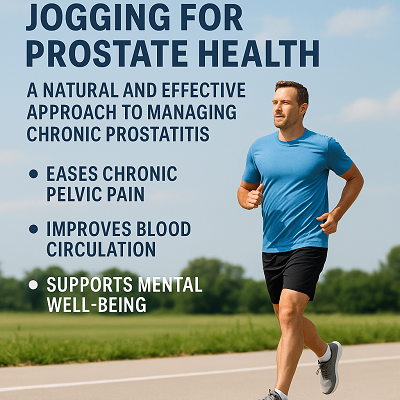Jogging for Prostate Health: A Natural and Effective Approach to Managing Chronic Prostatitis
Living with chronic prostatitis or chronic pelvic pain syndrome (CP/CPPS) can feel overwhelming. From discomfort during urination to lower abdominal pressure, the symptoms can interfere with daily life and mental health. While medications can offer relief, many men are now exploring non-pharmaceutical approaches—like jogging—to take back control of their health naturally.

In this article, we explore how jogging can improve blood circulation, enhance pelvic muscle function, and support mental well-being, making it a surprisingly effective tool in managing chronic prostatitis.
Why Jogging? The Science Behind the Stride
Jogging isn't just good for your heart—it's great for your prostate, too.
1. Boosts Pelvic Blood Circulation
Poor blood flow is one of the underlying issues in chronic prostatitis. Jogging helps promote systemic and localized circulation, particularly in the lower pelvic area. This improved blood flow:
- Delivers more oxygen and nutrients to the prostate
- Facilitates the removal of inflammatory toxins
- Reduces tissue congestion
2. Strengthens the Pelvic Floor
Jogging engages the core and pelvic floor muscles, gently strengthening them over time. This helps support:
- Better bladder control
- Reduced pressure on the prostate
- More efficient urination and ejaculation
3. Releases Endorphins to Reduce Pain
Physical activity like jogging stimulates the release of endorphins—the body's natural painkillers. For chronic prostatitis sufferers, this can mean:
- Decreased chronic pelvic pain
- Less reliance on pain medications
- Improved mood and stress resilience
Jogging for Mental Wellness
Chronic prostatitis isn't just a physical condition—it often comes with psychological stress, anxiety, or even depression. The repetitive motion and rhythmic breathing of jogging help calm the mind. Long-term jogging has been shown to:
- Reduce cortisol (stress hormone) levels
- Promote better sleep
- Create a positive cycle of physical and emotional recovery
How to Jog for Prostatitis Relief: A Safe Step-by-Step Guide
Not every jog is created equal, especially for someone with pelvic discomfort. Here's how to make it work for you:
Step 1: Timing is Everything
- Jog at least 1 hour after meals to avoid abdominal pressure.
- Ideal time: Morning or late afternoon when temperatures are moderate.
Step 2: Choose the Right Surface
- Opt for flat, cushioned ground (e.g., grass tracks, rubber running tracks) to minimize impact.
- Avoid hard surfaces like concrete.
Step 3: Warm-Up Matters
Spend 5–10 minutes doing:
- Light stretching
- Hip rotations
- Gentle squats
This prepares your muscles and pelvis, preventing strain.
Step 4: Start Slow and Stay Consistent
- Start with 15–20 minutes of light jogging, 3–4 times per week.
- Gradually build up to 30–45 minutes as your body adapts.
Consistency—not speed—is key.
Step 5: Cool Down
End each session with:
- Gentle walking for 5 minutes
- Deep breathing and stretching
This helps prevent muscle stiffness and supports circulation.
Common Mistakes to Avoid
- Overexertion: Don't jog to the point of exhaustion—fatigue can worsen inflammation.
- Ignoring discomfort: If you experience sharp pelvic pain, stop and rest.
- Inconsistent routine: Sporadic jogging is less effective than a steady weekly habit.
Combine Jogging with Herbal Support for Faster Results
Jogging can significantly ease symptoms, but combining it with internal herbal therapy often yields faster, longer-lasting relief.
Diuretic and Anti-inflammatory Pill
A time-tested traditional Chinese medicine formula, this pill helps:
- Eliminate heat and dampness
- Promote urination and reduce inflammation
- Improve blood flow in the prostate region
It works particularly well alongside jogging, as improved circulation from exercise enhances herbal absorption and therapeutic effects.
Learn more or order Diuretic and Anti-inflammatory Pill here.
A 30-Day Jogging Plan for Prostatitis
| Week | Frequency | Duration | Goal |
| Week 1 | 3x/week | 15–20 mins | Build habit, warm-up focus |
| Week 2 | 4x/week | 20–25 mins | Engage core and pelvic floor |
| Week 3 | 4x/week | 30 mins | Improve circulation |
| Week 4 | 5x/week | 30–40 mins | Maintain rhythm and recovery |
Final Thoughts: Jog Toward Healing
Chronic prostatitis doesn't have to control your life. By incorporating jogging into your routine—and supporting your body with herbal treatments like the Diuretic and Anti-inflammatory Pill—you can manage your symptoms naturally, without harsh medications or invasive therapies.
So lace up those running shoes. Your road to recovery might just begin with a single step.



